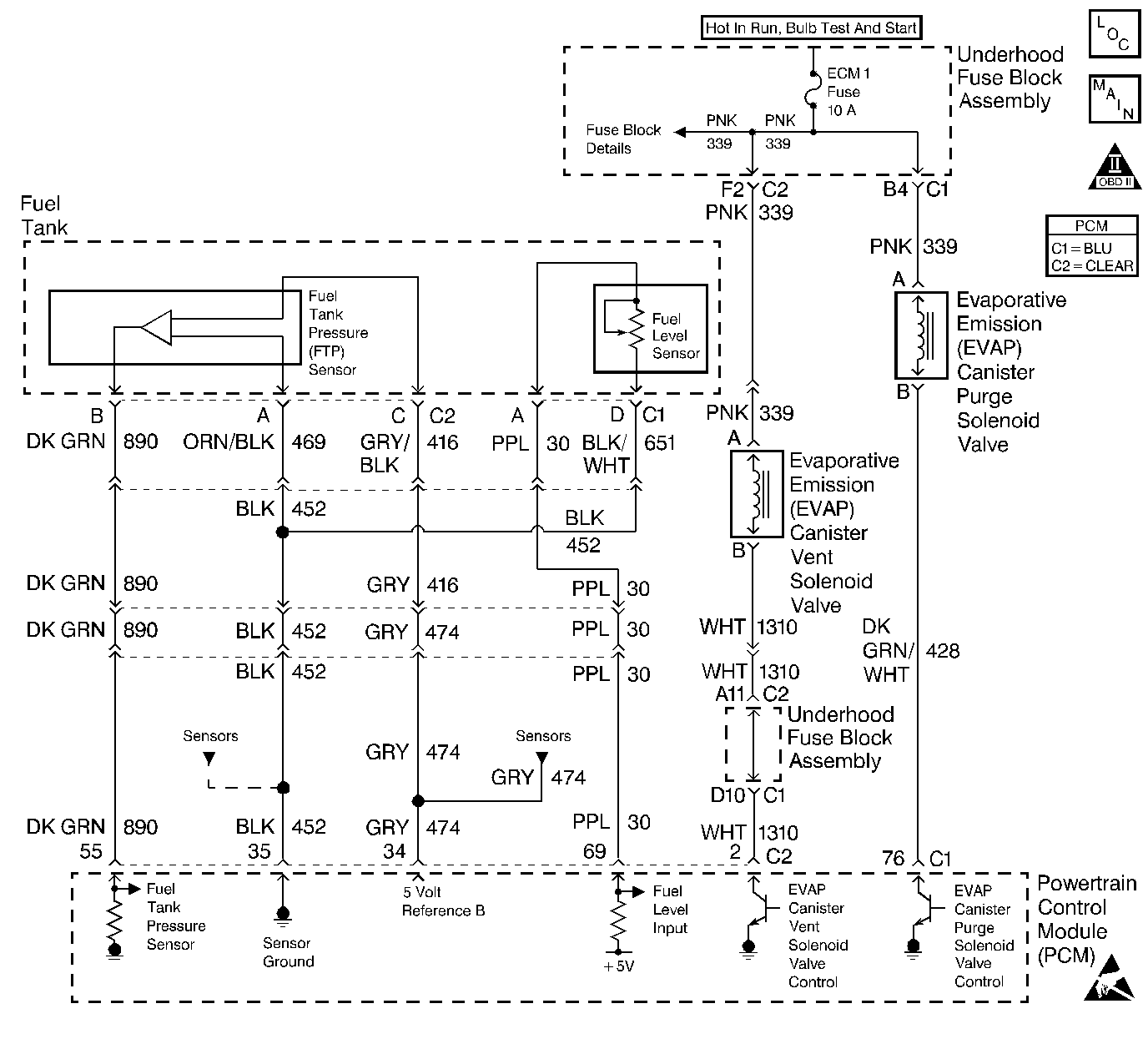
Circuit Description
The PCM monitors the fuel tank pressure sensor signal to detect vacuum decay and excess vacuum during the enhanced EVAP diagnostic. The fuel tank pressure sensor measures the difference between the air pressure (or vacuum) in the tank and the outside air pressure. The PCM applies a 5.0 volt reference and ground to the sensor. The sensor will return a signal voltage between 0.1 and 4.9 volts. If the PCM detects a fuel tank pressure sensor signal that is excessively high, DTC P0453 will set.
Conditions for Running the DTC
| • | No misfire, fuel trim, injector control circuit, AIR, EGR, VSS, HO2S, TP, MAP, MAF, ECT or IAT DTCs set. |
| • | Battery voltage is between 5 and 18 volts. |
| • | Barometric pressure is more than 75 kPa. |
| • | Fuel level is between 15% and 85% of full capacity for at least 10 seconds continuously. The time limit is required because fuel sloshing within the tank may cause the fuel level indication to vary outside the fuel level limits. |
| • | ECT at start up was between 4°C and 30°C (40°F and 86°F). |
| • | IAT at start up was between 4°C and 30°C (40°F and 86°F). |
| • | ECT not more than 8°C above or 2°C below IAT at start up. |
Conditions for Setting the DTC
| • | The fuel tank pressure sensor signal is greater than 4.9 volts. |
| • | The conditions is present for 5 seconds. |
Action Taken When the DTC Sets
| • | The PCM illuminates the malfunction indicator lamp (MIL) on the second consecutive ignition cycle that the diagnostic runs and fails. |
| • | The PCM records the operating conditions at the time the diagnostic fails. The first time the diagnostic fails, the PCM stores this information in the Failure Records. If the diagnostic reports a failure on the second consecutive ignition cycle, the PCM records the operating conditions at the time of the failure. The PCM writes the conditions to the Freeze Frame and updates the Failure Records. |
Conditions for Clearing the MIL/DTC
| • | The PCM turns the MIL Off after three consecutive drive trips that the diagnostic runs and does not fail. |
| • | A last test failed (current DTC) clears when the diagnostic runs and does not fail. |
| • | A History DTC clears after forty consecutive warm-up cycles, if this or any other emission related diagnostic does not report any failures. |
| • | Use a scan tool in order to clear the MIL/DTC. |
| • | Interrupting the PCM battery voltage may or may not clear DTCs. This practice is not recommended. Refer to Powertrain Control Module (PCM) Description , Clearing Diagnostic Trouble Codes. |
Diagnostic Aids
Notice: Use the connector test adapter kit J 35616-A for any test that
requires probing the following items:
• The PCM harness connectors • The electrical center fuse/relay cavities • The component terminals • The component harness connector
If the problem is intermittent, refer to Intermittent Conditions .
Test Description
Number(s) below refer to the step number(s) on the Diagnostic Table.
Step | Action | Value(s) | Yes | No |
|---|---|---|---|---|
1 | Did you perform the Powertrain On-Board Diagnostic(OBD) System Check? | -- | ||
2 | Observe fuel tank pressure sensor voltage on the scan tool. Is fuel tank pressure sensor voltage greater than the specified value? | 4.7V | ||
3 |
Does the scan tool indicate DTC P0453 failed this ign? | -- | Refer to Diagnostic Aids. | |
4 |
Is fuel tank pressure sensor voltage near the specified value? | 0V | ||
5 |
Was a problem found and corrected? | -- | ||
6 |
Was a problem found and corrected? | -- | ||
7 |
Was a problem found and corrected? | -- | ||
8 |
Was a problem found and corrected? | -- | ||
9 | Replace the fuel tank pressure sensor. Refer to Fuel Tank Pressure Sensor Replacement . Is the action complete? | -- | -- | |
Replace the PCM. Important:: The replacement PCM must be programmed. Refer to Powertrain Control Module Replacement/Programming . Is the action complete? | -- | -- | ||
11 |
Does the scan tool indicate that this test ran and passed? | -- | ||
12 | Review Captured Info using the scan tool. Are there any DTCs that have not been diagnosed? | -- | Go to the applicable DTC table
| System OK |
